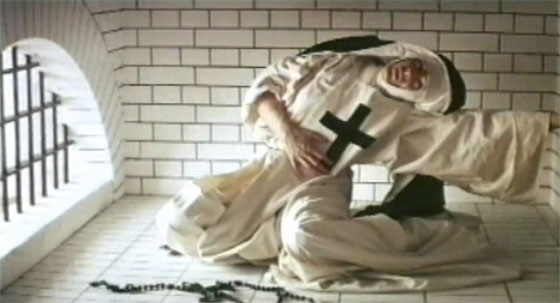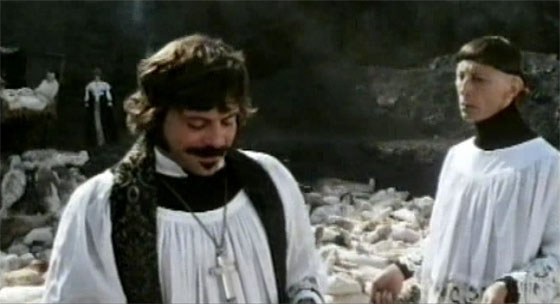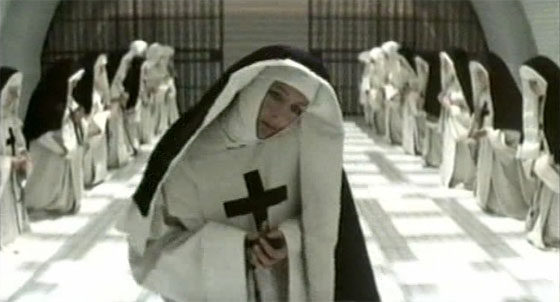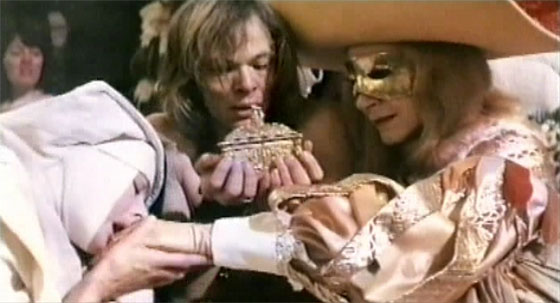
By far Ken Russell’s most controversial work, The Devils (1971) is not merely content to be sacrilegious and shocking; it seeks a state of hysteria that cinema rarely achieves. Though the film is now four decades old, it hasn’t lost its power. Edited versions of the film have turned up on home video over the years, and bootlegs abound, but it has never been issued on DVD in the United States, and a forthcoming official release in the U.K. will not contain the full uncut version. Given the transgressive nature of so much that is readily available these days, and the status of The Devils as a major cult film, the reticence on the part of Warner Bros. seems somewhat old-fashioned, if not ridiculous. It ought to be widely available to film students everywhere, for though it’s a flawed film, it’s also a significant one in many ways. Oliver Reed and Vanessa Redgrave deliver career-high performances. The memorable sets were designed by filmmaker Derek Jarman. The screenplay, by Russell, is based on a famous play of the same name by John Whiting (adapted from the book The Devils of Loudun by Aldous Huxley), and borrows material from an opera by noted avant-garde composer Krzysztof Penderecki. And, most of all, this is a Ken Russell movie made during his early-70’s prime. It’s wild, raw, and taboo-busting. People will object to it, but people will also want to see it; and the more you suppress the film, the more you inadvertently add to its legend. The Devils is nothing if not legendary.

Father Grandier (Oliver Reed) proudly speaks of his power to Father Mignon (Murray Melvin) before a pit of plague-ridden corpses.
Reed plays Father Grandier, a priest of the walled town of Loudun whose prominence approaches celebrity status. When the governor dies of the plague, Grandier virtually replaces him, and quickly comes to enjoy his newfound power. He impregnates the daughter of the magistrate, then quickly scorns her. He falls in love with a pretty young woman named Madeline de Brou (Gemma Jones), and marries her in secret. When Baron De Laubardemont (Dudley Sutton) acts on behalf of King Louis XIII (Graham Armitage) and attempts to tear down the city – part of Cardinal Richelieu’s plans to consolidate power throughout France – Grandier takes control of Loudun’s forces and threatens his life unless he withdraws his men. Laubardemont retreats, but soon hatches a plot of revenge. He terrorizes the nuns of the “Enclosed Order,” led by the hunchbacked and sexually deranged Mother Superior, Sister Jeanne of the Angels (Redgrave). After Sister Jeanne is brutally “exorcised” by a psychotic witch-hunter named Barre (Michael Gothard) – she’s raped with an enema – and the nuns are threatened with execution, they’re spared under the condition that they fake a mass possession by devils, with Father Grandier as the source of the evil. The convent is reduced to a chaotic and violent orgy, and Grandier is arrested, placed on trial, tortured, and sentenced to be burned at the stake.

The deformed Sister Jeanne (Vanessa Redgrave) and her order of sinful nuns.
Russell’s previous effort was The Music Lovers (1970), but for all of that film’s scandalous touches, there were only hints – in particular his treatment of Glenda Jackson’s unhinged Mrs. Tchaikovsky – that a greater madness lurked just round the corner. The Devils kicked wide the asylum gates, and let the inmates run riot. The sexuality is graphic; the violence is horrific; and any regular church-goers should really keep a wide berth. It’s interesting how Russell lets this unfold. At first Reed’s Father Grandier seems to be the heart of the corruption, and his treatment of the pregnant Madeline is shockingly callous. A scene in which he strides the length of a pit of the dead (all ravaged by the plague) while speaking casually of the satisfaction he takes from power and lust is equally shocking. But none of this compares to the perverse imagination of Sister Jeanne. While praying to a statue of Christ, she fantasizes that the object of her lust, Grandier, is hanging from the cross with a crown of thorns upon his head. Then he descends to her for an erotic embrace, and she kisses the stigmata and plunges her tongue down the spear-wound in his side. When she awakens from this blasphemous reverie, she discovers that she’s stabbed a bloody hole into her palm with a crucifix. The nuns she oversees behind the bars of the convent are no more holy. They stage a mock wedding in parody of Grandier’s not-so-secret ceremony, a minor prelude to the later orgy in which they all-too-passionately indulge. Their sin is matched only the sadism of Baron De Laubardemont, Father Barre, and those they command, including two maniacal physicians whose supposedly-professional expertise is lethal. Russell films every taboo in the most sensationalistic manner he can dream up – like a Surrealist’s experiment in provocation. In the notorious “rape of Christ” scene (cut from most prints of the film) – when the nuns climax their orgy by taking down a statue of Jesus before humping it, while one unclothed nun swings spread-eagled from the ceiling – Russell turns the camera on one of the instigators of this madness, the corrupt Father Mignon (Murray Melvin), and spasmodically zooms in and out on his face while he masturbates. The phrase “over the top” does not do justice. (As pointed out in Mark Kermode’s documentary “Hell on Earth,” the scene is deliberately juxtaposed with Father Grandier’s personal communion with God, making clear that his own spirituality is becoming more genuine, while his accusers have submitted to complete corruption.)

Sister Jeanne, faking demonic possession under the command of Father Barre (Michael Gothard), kisses the hand of the disguised Louis XIII (Graham Armitage).
Critics did not react kindly to The Devils, some decrying it as pornography and a pointless exercise in sadism. It was cut in the States, but still received an X-rating on its initial release (it was later cut down further, to garner an R). Some countries banned the film outright. At least Russell could see the immediate result of his experiment in extremes: censorship and suppression. He’d made a film spectacle that was increasingly difficult for anyone to see. But visiting the film forty years later, and placing it in the context of the late director’s now-completed body of work, we can see it as a defining moment. The Devils made it clear to everyone, forevermore, what “A Ken Russell Film” really meant. He had made a name for himself with Women in Love (1969), but now he was an auteur that the film world had to reckon with. From here on out, he would be either scorned or adored; no middle-ground could be struck. But The Devils, behind its heavy curtain of shock value, is still a good story wittily told. The script is full of little jokes and sharp characterizations (it helped that Russell’s screenplay had a firm foundation, from the historical reality of the events to Whiting’s vivid players). The film’s final scenes, in which Grandier is dragged through the ringer, succeed in evoking righteous outrage in the viewer as well as – hat-trick here – enormous sympathy for Father Grandier, the very man who inspired such loathing early on. He repents and comes to peace with God, but it is not the confession that Laubardemont is seeking. We feel the injustice viscerally; everything, of course, is delivered at the visceral level here. Finally, all that intensely-felt sacrilege committed by those wearing holy robes not only demolishes the divine authority of The Church, but all of that institution’s awe and power. To this end, the film is part of a long, rich tradition – once literary (such as in M.G. Lewis’ The Monk), now cinematic (Buñuel’s ouvre). The Devils offends and disturbs, but as a film and an important piece of art, it succeeds magnificently.









